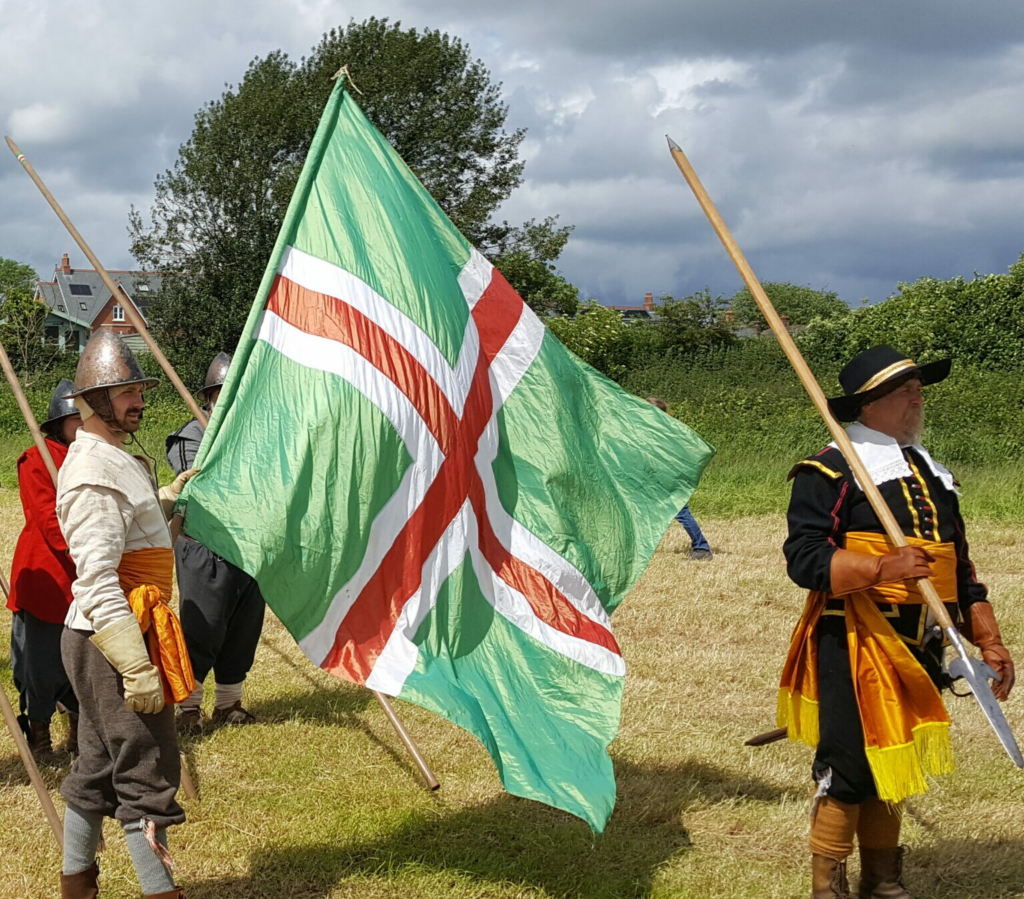Origin – The Norfolke Trayned Bandes were founded in 1974 at the University of East Anglia in Norwich. We celebrated our. 50th anniversary in 2024. Fifty years of reenactment have led to us becoming a multi-generation Regiment with many family groups. This helps to create a strong community atmosphere in which new members are made to feel very welcome. We eat together, we sing together, and we have a whole bunch of crazy traditions in which new members are free to participate in/ avoid like the plague, depending on their personal preference!
From our Norfolk beginnings, we have grown to have members all over the country and also overseas, who all come together to take part in events.
Women have been part of the regiment from the very start, and are well represented within the ranks of pike and musket.
Flag – Our flag has the red cross of St George with a white border, and a green background to represent the green fields of Norfolk. The Colour is carried by our Ensign. Ensigns, like all other officers did not wear uniform. Wearing your own expensive clothing was a sign of status. His orange sash shows that we are fighting on the side of Parliament.

Uniform – as you can see below, our costume is not really a uniform at all. There is great variation in headgear, and the colour of socks, doublets, and breeches changes from person to person.
This is intentional. The Trained Bands have a different history to other regiments. They were primarily a defensive force and each County had its own trained bands. Membership of the Trained Bands was compulsory for freeholders, householders and their sons (in other words, well to do people, men with some money); they were expected to defend the country from foreign invasion or local rebellion. In practice, servants and hired substitutes were often sent to attend the training sessions, which were held once a month during the summer. Members of the trained bands didn’t have a uniform, they just wore their own clothes, though it is possible that those men sent as substitutes might have been given better clothing by their employer.

The Norkolks have a reputation for enthusiasm in battle, and many really enjoy that aspect of our hobby.
Battle Braids – Fablous French plaits worn by several members with really long hair. They keep your hair safely out of the way during combat and look great.

Historical Research – One of our regimental members, Stuart Peachey, has conducted a great deal of research to guide us on the authenticity of period clothing, food, etc. You can buy his books via Stuart Press, and they may also be available at musters. (Another good source of information about military history is Caliver Books.)
While it is possible to buy accurate replica costume and kit items, making your own is a great way of really getting to grips with the period. If this appeals to you, we have many skilled people who can provide advice and support on specific aspects of the hobby, such as making authentic clothing.
Living History – We do have members on the Living History encampment at musters, as well as a large group who spend a week each year teaching schoolchildren about the period on a hill farm in South Wales. The farm is the one that was used for the BBC series, ‘Tales from the Green Valley’, which you can watch here. It’s an excellent way to learn about everyday life on a farm in the early 17th century.
We participate as soldiers on some Living History sites, such as Corfe Castle in 2024 and at most smaller events
For some smaller events, a number of our members switch from their battlefield roles to take on the identity of everyday civilians going about their work. These roles can vary depending on the requirements of the event, and can range from portraying nobility down to the humblest kitchen servant.
Singing, whether around the campfire or in a pub, is something that the Norfolks are well known for. We have a great bunch of singers, who can belt out the choruses.
Circle of Death – a Norfolke campfire tradition. Various people bring bottles of alcohol, ranging from Homebrew all the way to fruit brandy. I believe port is normally part of the offering. There’s no compulsion to bring anything, but cake is always appreciated, especially when homemade. Bottles circulate clockwise around the campfire (except for port, of course, which is always passed to the left – you should never pass port to starboard!). Those who wish to, take a sip from the bottle and pass it on. Those who prefer not to, simply pass the bottle on.
Cuddly Toys Everyone likes an appropriate Cuddly Toy. In our case , the Norfolke Pike and the Norfolke Ratte. The pike, hopefully, is an obvious mascot… (though there are good places to fish for Pike in Norfolk). The rat has a slightly more complicated history. Back in the 1920s, coypu, a type of South American beaver, looking just like a giant rat, were brought into Norfolk by the fur farming industry. During the Second World War, many of them escaped into the wild and bred rapidly. By the 60s they had become a serious pest, causing a lot of economic damage. They were finally eradicated in the early 80s. Students at UEA, were very familiar with coypu: they were popular on T-shirts, in rag magazines, etc.
